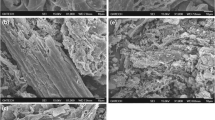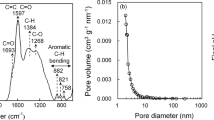Abstract
Hg(II) Retention capacities of nine bryophyte species, collected from Jinfo Mountains (JFM) in Chongqing, China, had been investigated with special reference to the effect of morphology and elevation of moss growth. Results indicated that adsorption capacities of bryophytes for Hg(II) became stronger with the increase of multi-branches and leafy-shoots, as well as the elevation of moss growth, which was observed both in adsorption isotherm and adsorption kinetics experiments. Contrarily, the desorption kinetics showed a decrease tendency with the increase of multi-branches and leafy-shoots and the elevation of moss growth. The results demonstrated that bryophytes with higher multi-branches and leafy-shoots and higher growth elevation had a stronger adsorption capacity and a weaker desorption tendency, and therefore had a stronger retention capacity to Hg(II). The results disclosed the different relative sensitivity and retention capacity of mosses to pollution resulting from heavy metals, due to the differences in growth elevation and morphology. These should be considered when bryophytes were chosen as a tool for biomonitoring materials to environmental pollution, especially caused by Hg(II).
Similar content being viewed by others
References
Berg, T., & Steinnes, E. (1997). Use of mosses (Hylocomium splendens and Pleurozium schreberi) as biomonitors of heavy metal deposition: From relative to absolute deposition values. Environmental Pollution, 98, 61–71.
Clough, W. S. (1975). The deposition of particles on moss and grass surface. Atmospheric Environment, 9, 1113–1119.
Couto, J. A., Fernández, J. A., Aboal, J. R., & Carballeira, A. (2004). Active biomonitoring of element uptake with terrestrial mosses: A comparison of bulk and dry deposition. Science of the Total Environment, 324, 211–222.
Crist, R. H., Martin, J. R., Chonko, J., & Crist, D. R. (1996). Uptake of metals on peat moss: An ion-exchange process. Environmental Science & Technology, 30, 2456–2461.
Fernández, J. A., Ederra, A., Núñez, E., & Martínez-Abaigar, J. (2002). Biomonitoring of metal deposition in northern Spain by moss analysis. Science of the Total Environment, 300, 115–127.
Fernández, J. A., Rey, A., & Carballeira, A. (2000). An extended study of heavy metal deposition in Galicia (NW Spain) based on moss analysis. Science of the Total Environment, 254, 31–44.
Folkeson, L. (1979). Interspecies calibration of heavy metal concentrations of nine mosses and lichens-applicability to deposition measurements. Water, Air and Soil Pollution, 11, 253–260.
Garty, J. (2001). Biomonitoring atmospheric heavy metals with lichens: Theory and application. Critical Reviews in Plant Sciences, 20, 309–371.
Hettiarachchi, G. M., Ryan, J. A., Chaney, R. L., & La Fleur, C. M. (2003). Sorption and desorption of cadmium by different fractions of biosolids-amended soils. Journal of Environmental Quality, 32, 1684–1693.
Larson, D. W. (1979). Lichen water relations under drying conditions. New Phytologist, 82, 713–731.
Lindqvist, O., Johansson, K., Aastrup, M., Andersson, A., Bringmark, L., Hovsenius, G., et al. (1991). Mercury in the Sweden environment – recent research on cause, consequences and corrective methods. Water, Air and Soil Pollution, 55, 1–261.
Magdefrau, K. (1982). Life-forms of bryophytes. In A. J. Smith (Ed.), Bryophyte ecology (pp. 45–59). New York: Chapman & Hall.
Nimis, P. L., Fumagalli, F., Bizzotto, A., Codogno, M., & Skert, N. (2002). Bryophytes as indicators of trace metal pollution in the River Brenta (NE Italy). Science of the Total Environment, 286, 233–242.
Puckett, K. J., & Finegan, E. J. (1980). An analysis of the element content of lichens from the northwest territories, Canada. Canadian Journal of Botany, 58, 2073–2089.
Richardson, D. H. S. (1981). The biology of mosses (pp. 1–220). Oxford: Black well Scientific Publications.
Samecka-Cymerman, A., Kolon, K., & Kempers, A. J. (2002). Heavy metals in aquatic bryophytes from the Ore Mountains (Germany). Ecotoxicology and Environmental Safety, 52, 203–210.
Schilling, J. S., & Lehman, M. E. (2002). Bioindication of atmospheric heavy metal deposition in the southeastern US using the moss Thuidium delicatulum. Atmospheric Environment, 36, 1611–1618.
Sprynskyy, M., Buszewski, B., Terzyk, A. P., & Namieśnik, J., (2006). Study of the selection mechanism of heavy metal (Pb2+, Cu2+, Ni2+, and Cd2+) adsorption on clinoptilolite. Journal of Colloid and Interface Science, 304, 21–28.
Steinnes, E. (1995). A critical evaluation of the use of naturally growing moss to monitor the deposition of atmospheric metals. Science of the Total Environment, 160/161, 243–249.
Tan, H., He, J. L., Liang, L., Lazoff, S., Sommer, J., Xiao, Z. F., et al. (2000). Atmospheric mercury deposition in Guizhou, China. Science of the Total Environment, 259, 223–230.
Vázquez, M. D., López, J., & Carballeira, A. (1999). Uptake of heavy metals to the extracellular and intracellular compartments in three species of aquatic bryophyte. Ecotoxicology and Environmental Safety, 44, 12–24.
Wells, J. M., & Brown, D. H. (1987). Factors affecting the kinetics of intra and extracellular cadmium uptake by the moss Rhytiadelphus squarrosus New Phytologist, 105, 123–137.
Xiao, Z. F., Sommar, J., & Lindqvist, O. (1998). Atmospheric mecury deposition on Fanjing Mountain nature reserve, Guizhou, China. Chemosphere, 36, 2191–2200.
Zechmeister, H. G., Hohenwallner, D., Riss, A., & Hanus-Illnar, A. (2003). Variations in heavy metal concentrations in the moss Abietinella abietina (Hedw.) Fleisch. according to sampling within site variability and increase in biomass. Science of the Total Environment, 301, 55–65.
Zhang, Z. Q., Zhang, Y. P., & Zhu, Z. H. (2000). Study on the characteristics of kinetic of cadmium retention on soils. Acta Scientiae Circumstantiae, 20, 370–375 (in Chinese).
Author information
Authors and Affiliations
Corresponding author
Rights and permissions
About this article
Cite this article
Sun, SQ., Wang, DY., He, M. et al. Retention capacities of several bryophytes for Hg(II) with special reference to the elevation and morphology of moss growth. Environ Monit Assess 133, 399–406 (2007). https://doi.org/10.1007/s10661-006-9594-x
Received:
Accepted:
Published:
Issue Date:
DOI: https://doi.org/10.1007/s10661-006-9594-x




